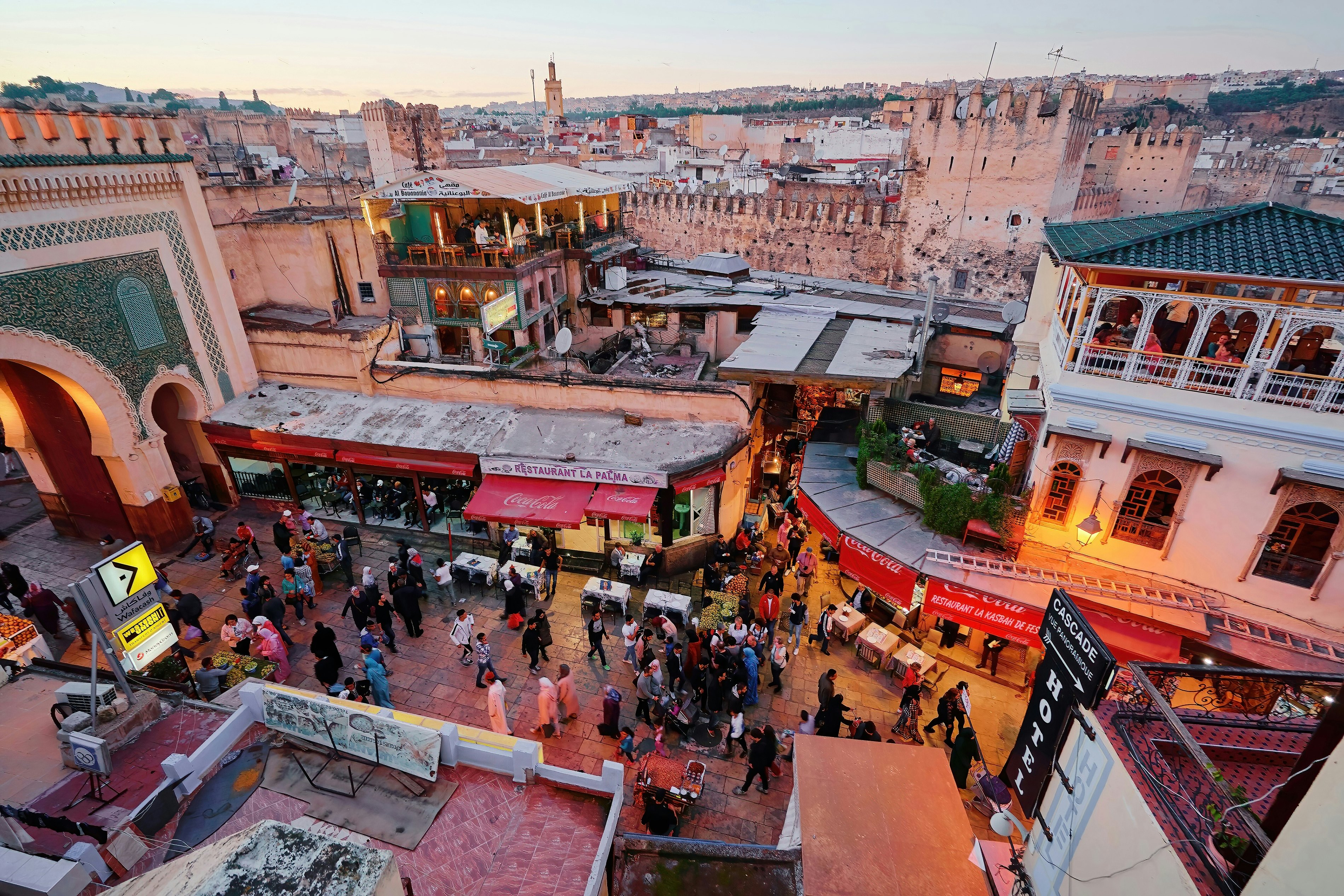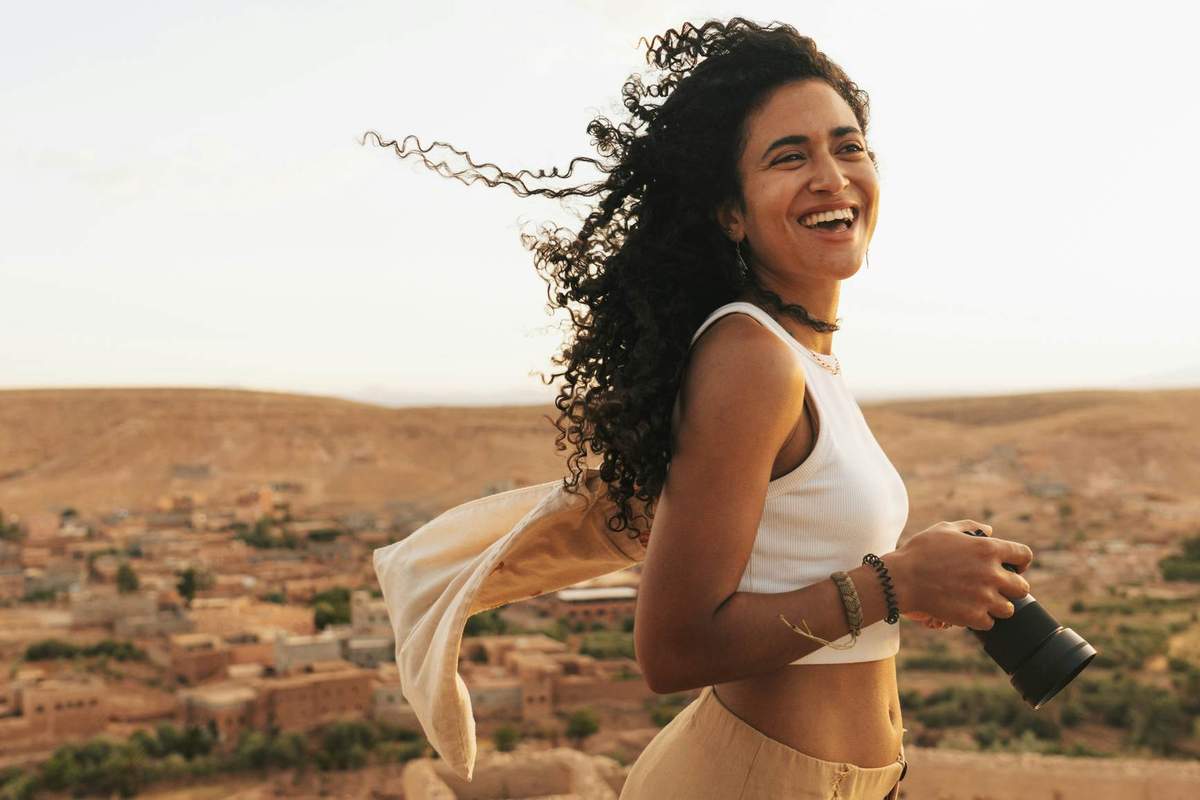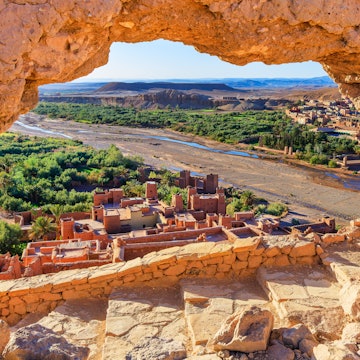

Bab Bou Jeloud, a gateway to the medina in Fez, Morocco. yalcins/Shutterstock
Fez isn’t a city of tidy neighborhoods and must-see monuments. Rather, it’s an intricate maze that seemingly defies logic, until revealing itself layer by layer. What you notice first aren't the monuments or museums, but the texture of daily life: limewash peeling to expose old brick, the scent of cedar from a carpenter’s stall, a burst of cumin from a grill or sesame cookies being dipped in hot honey, the clang of a coppersmith’s hammer echoing through a derb (alleyway) as a carossa (street cart) driver shouts “balek, balek!” – watch out! – while squeezing past.
Carts piled with seasonal fruits trundle by medieval, zellige-tiled fountains; schoolchildren dart through archways worn smooth by centuries of footsteps; so many minarets puncture the skyline. Fez is not one to give itself away all at once, but should be absorbed through small, ordinary moments that feel anything but. The secret is not to rush. Spend a morning wandering the courtyards of a medersa (school for studying the Quran) or learning a traditional craft, linger over a slow-cooked tagine in the shade of a hidden garden, never miss a rooftop sunset, and always leave time for the unexpected – a detour down an unfamiliar alley, a glass of tea with a carpet merchant, an invitation for Friday couscous. The gift of Fez lies in these unscripted moments, when you stop searching and let the city seep quietly under your skin.

1. Dive into Fez with a workshop at Moroccan Culture 101
Café Clock has long been a cultural hub in Fez, known for its camel burger, live music and storytelling nights. Its Moroccan Culture 101 workshop offers a relaxed way to decode medina daily life, from the importance of greetings, to distinctions between Arab and Amazigh traditions, to the changing roles of women in modern life. You’ll learn a few Arabic phrases, common gestures and local etiquette, and get the chance to ask about everything from henna rituals to faux guides, politics and religion helping you move through the city with confidence and respect.
Local tip: Factor this in to your first day in Fez perhaps bookending it with coffee (the best in town) and a late breakfast (Amazigh eggs) or early lunch – try the legendary camel burger.
2. Explore the city's artisanal heritage on a scavenger hunt
Culture Vultures’ self-guided adventures are designed to take you deep into the city’s living craft traditions. Starting from a local cafe with a quick briefing and drink, you’ll follow a series of clues that introduce you to artisans in their workshops uncovering age old techniques of zellige (colorful geometric mosaic tilework), weaving, leatherwork and more, that have earned Fez the moniker City of Artisans. QR codes unlock videos and stories that deepen the experience as you explore. Designed for curious, independent travelers, the hunt takes a few hours. Email to book and receive your first clue.
Detour: Want to dig deeper? Culture Vultures also offers guided textile, pottery and craft quests lasting from three to 15 days, that take you deep into the heart of Morocco’s ancestral traditions.

3. Take a photography tour
Join photographer and cultural entrepreneur Omar Chennafi on a curated photography tour blending visual exploration with cultural insight. The experience invites you to observe daily life through a creative lens capturing moments that reveal the city’s rhythm, history and authentic Fassi spirit. Designed for all levels and interests, the tour guides you through the medina’s lively streets and hidden courtyards with practical advice on photography techniques and visual storytelling. Along the way you’ll pause for tea, conversation and reflection on the art of seeing.
Local tip: If you decide to strike off on your own, be very aware of how the camera is perceived in Morocco. Always ask permission before taking a photo of someone – knowing that oftentimes a small tip will be appreciated – and always back off if your subject says no.
4. Experience the peace of a riad courtyard
Fez moves to a gentler rhythm than Marrakesh, offering quiet courtyards and easy-going evenings on roof terraces. At Riad Laaroussa or Dar Bensouda, hammams fill with orange blossom-scented steam offering a soothing pause after a day in the medina. Fondouk Bazaar serves hearty salads and sharing platters worth lingering over, while the Ruined Garden and Jardin des Biehn are idyllic spots for lunch amid leafy gardens and tumbling bougainvillea. For dinner, Dar Roumana's candlelit courtyard sets the mood for romance, and as the sun goes down the cascading roof terraces at Palais de Fes Dar Tazi offer immense medina views to soak up over a glass of Moroccan rosé.
Detour: Fancy a night in the countryside? A 45-minute drive away, magical Dar el Mandar gives you a taste of rural life with sweeping views over the Saiss plains and terraced gardens that include a pool and traditional Amazigh tents for a snooze in the shade.

5. Visit Fez’s heritage museums
Set in a 19th-century Andalusian-style palace, the Dar Batha Museum has reopened after major renovation, offering a thoughtful journey through Fez’s history from its medieval foundations to modern times. Fassi ceramics, carved wood, zellige and textiles illustrate the city’s craftsmanship, while the lavish replanted gardens, with their shaded paths and fountains, promise to bloom into one of Fez’s loveliest green spaces.
Deep in the heart of the medina, the Nejjarine Museum of Wooden Arts and Crafts occupies a magnificently restored funduq, an inn and market used by merchants. Its cedar galleries display Morocco’s woodwork traditions – finely carved doors, furniture, instruments and tools – revealing the skill and artistry of Fassi crafters.
Detour: Keen for a little more green? Don’t miss a morning walk along the paved mountain trail from Bab Jdid to the American Fondouk, or an afternoon stroll around the Jnane Sbil gardens.
6. Learn to weave in a hands-on workshop
Anou is one of Morocco’s most forward-thinking cooperatives, bringing together more than 600 artisans while ensuring both profits and decision-making remain in their hands. At the Fez workshop, weaving is taught through experience rather than demonstration. On the rooftop, steam rises from dye vats infused with pomegranate rind, saffron and poppies, while vivid skeins of wool hang drying in the sun. Below, in a centuries-old courtyard, visitors work on small looms under the patient guidance of an artisan. You’ll choose colors from the Wall of Wool, sketch a design, and knot your own piece.
Detour: Anou can also arrange visits to artisans across the whole of Morocco, so if you’d like to meet the person that made your rug, join them for tea or lunch, or even learn to spin wool, this is a great way to enhance your experience.

7. See how exquisite textiles are made by loom
Only two places still use hand-operated draw looms: Cholapur near Varanasi in India, and Fez. The loom looks deceptively simple until you notice the cords and shafts that allow intricate motifs to be pre-programmed into the weave – a breakthrough that once revolutionized textile making as profoundly as the printing press changed books. At Dar al Tiraz, a guided visit showcases the process through the rhythm of pedals, the pull of ropes, manual beaming and warping. Then, under master weaver Hassan Kabil, participants learn to set up pattern shafts and experiment with their own designs. Workshops (2 hours, 400Dh) require a minimum of three people and take place in the medina studio.
Local tip: If time is limited, visit master-brocade maker Abdelkader Ouazzani, who weaves exquisite textiles combining silk with gold and silver threads in his atelier at Lalla Yeddouna.
8. Tour Fez's traditional and contemporary architecture
Iraqi-born architect Alaa Said, who studied at the Oslo School of Architecture (AHO), has spent more than two decades restoring Fez’s historic houses. From Dar Seffarine, the 600-year-old guesthouse he and his wife Kate painstakingly restored, he leads a 4-hour architectural tour that unravels the medina’s honeycomb layout explaining how narrow derbs channel air and why homes turn inward to reveal tranquil courtyards. The walk passes dars (traditional houses) and riads in various stages of restoration as Alaa discusses the challenges of adapting heritage buildings for modern life.
Detour: For a self-guided contemporary contrast, explore the medina’s Place Lalla Yeddouna or have lunch at modern hot spot Ishq. Hit the Ville Nouvelle to eye the Hotel Sahrai and the recently restored art deco facades along Ave Mohammed V. Hop in a grand taxi to admire Zevako’s brutalist hot springs at Sidi Harazem.
9. Savor Moroccan home cooking
For small groups the Courtyard Kitchen at Dar Namir takes a deep dive into the city’s culinary heritage. Each session includes five dishes ranging from goats cheese briouats (cigar-shaped or triangular stuffed pastries), to chicken daghmira with caramelized onions, beef kefta scented with rose petals, and the city’s beloved kaab el ghazal (gazelle’s horns), as well as learning how to make essential aromatics like preserved lemons and hand-ground ras el hanout.
The day begins with a market tour in Rcif, sampling local specialties before returning to a tranquil private house to cook. Set in a relaxed, authentic atmosphere, it’s an immersion into the flavors and rhythms of Moroccan home cooking.
Local tip: The Courtyard also offers a Traditional Foods of the Fez Medina tasting tour with a qualified guide, which introduces you to nine of the city’s most emblematic foods, from breakfast bissara, to wild honey, to camel kefta. Come hungry.

10. Wander the medersas
Fez’s three accessible medersas (schools for studying the Quran) – Bou Inania, Attarine and Cherratine – capture the city’s intellectual and artistic brilliance. The Bou Inania, on Talaa Kebira, is the most magnificent, its marble courtyard, carved cedar and onyx columns still alive with the rhythm of prayer. The Attarine, near the Karaouiyine Mosque, dazzles with intricate zellige, stucco and Kufic calligraphy, while the Cherratine, built later, is austere and contemplative, its narrow cells once housing theology students. Other notable medersas – Mesbahiyya, Sahrij and Seffarine – remain closed, though their restoration is eagerly awaited, promising a fuller picture of Fez’s scholarly legacy.
Local tip: These days Google Maps will serve you fairly well in the medina, but in the more knotted areas it’s still easy to get turned upside down, and that’s when this one little trick comes in very handy. If the street sign is a square, it's a through road. If it’s a hexagon, it means it's a dead end.
11. Feast on street food in the Achabine Souks
Famille Berrada and Salah Canteen, in the Achabine Souks, are local lunchtime favorites and still draw the crowds who want to sit down in comfort, but you’ll have the most fun hopping from stall to stall sampling different foods. Try chermoula-spiced fried fish, crispy breaded liver, silky aubergines and irresistible chips, steamed sheep’s head to dip in cumin, and chilli spiked chicken stuffed with vermicelli. Rachid still grills smoky kefta to pack into khobz (bread) fresh from the oven, and on the small square by Mosquée El Qaffazine, locals tuck into some of the city’s best lobia (white beans stewed with turmeric) and addis (lentils stewed with tomatoes, paprika and cumin).
Local tip: Between these smoky stalwarts, newcomers like Medina Coffee, serving juice and ice cream, or Café Sara, for mint tea and cookies under an orange tree, are ideal for a post-prandial repose.
12. Hike the hills of Mt Zalagh
With Soufiane from the Green Caravan as your guide, Mt Zalagh is explored at an easy pace, winding through olive groves and scrubby hills to the panoramic summit. Along the way, he shares stories of the landscape, pausing for views and small touches that make the day memorable, such as tea brewed on the spot and a hammock slung between trees. For those with limited mobility, he can arrange transport to the top so everyone can enjoy the view. It’s close enough to the city for a morning or afternoon outing, but better still if you make a day of it with picnic fare from Rcif market – cheese, bread, fruit, nuts and cookies.
Detour: The Green Caravan offer eco-conscious trips all over Morocco including some wonderful day and overnight trips from Fez.















